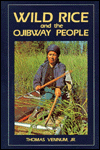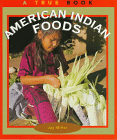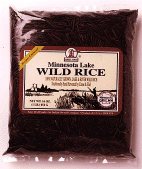Please Help Preserve Ojiway Culture!
Buy Kagiwiosa Manomin Wild Rice to help preserve cultural activities, self-directed economy and community development. The community cooperative enables Ojibway harvesters to make a living from a traditional activity. Preserving Manomin as a truly WILD food helps to preserve the Wabigoon Ojibway way of life.
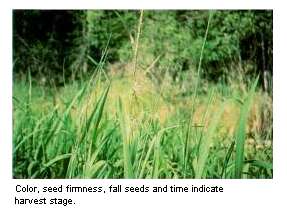
Native American Food
Wild Rice
Brought to you by Lame Wolf's Den
Wild Rice is a staple in the diets of many Indian people. It is a sacred grain that traditionally is very important. It grows as 8-12 feet tall reeds in the lakes of Wisconsin and Minnesota and their northern marshes. There are thousands of different varieties, each growing in their own individual depth, temperature, and water quality. Being very sensitive to its environment, wild rice does not like change. It is perfectly adapted to the natural world in which it is growing.
Good Books!
Click on Cover or Title for more information
Traditional "ricing" is still done in canoes. A long pole must be used to push the canoe along, while another person uses two long sticks called "knockers" to knock the ripe grains into the canoe. With one knocker the rice reed is bent down into the canoe. Then using the other knocker, the head of the reed is hit sharply. The ripe grains fall into the canoe. The aim is to keep the long, pointed seeds as unbroken as possible. It can take from 2 hours to most of the day to fill up a canoe. Never is all the rice taken. Some is always left to re-seed the lake.
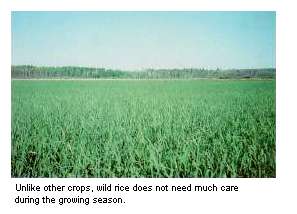
Harvest is a time of hard work.
Indian people follow the old ways as nearly as possible. Some people will build a drying rack from green branches with a slow fire under it. The shelves are lined with dried grass. A lot of the first rice is dried quickly that way. The rest is spread on big canvases in part-sun to dry more slowly.Native Indian Wild Game, Fish & Wild Foods Cookbook : Recipes from North American Native Cooks
Best of Wild Rice Recipes
by: Ojakangas, Beatrice Quality Paperback
Buy Now! for 10% to 40% off the retail price.
After the rice is dried, it is parched to loosen the husks. Whatever amount of dried rice you are parching, it must be stirred constantly for about an hour. This parching loosens the husks and gives it a nice flavor when boiled. Care should be taken not to burn the rice.
The rice is then pounded. This is done in a barrel with long, thick pointed poles. The poles have been sanded very smooth. They are lifted up high, then dropped down along the sides of the barrel. This jostles off the husks without breaking up the grain. The rice is then emptied onto big birchbark trays or sometimes just in blankets and lightly tossed. This blows away the chaff and the heavier grains fall back onto the tray. This is called "winnowing" the rice.
Winnowed rice still has a few pieces of inner husk sticking to it which is edible. Traditionally, men "jig" the rice to separate the edible chaff. The winnowed rice is put in a barrel lined with deer hide. The barrel is sunk into the ground with two thick branches mounted next to it. A man gets in the barrel with new deerskin boots on and dances or "jigs" on the rice. His full weight must never come down on the rice. He uses the two branches as hand holds so he can jig very lightly. This breaks away the inner husks without breaking up the rice. This chaff is mixed into little patties and fried or served as a mush.
Rice processed the same day it is harvested is called green rice. It has lighter color and a different flavor than sun-dried rice. If rice is dried for several days in the sun, it turns very black and it will keep for years. If not too broken up, it can also be used as seed grain to re-seed damaged and over-harvested lakes.
Our grandmothers would go out on the rice lakes about two weeks before the first rice harvest. They would tie some narrow bundles of the reed heads into tight bundles with twine. It could take several days to tie up lots of bundles. The twine was removed later in the winter and the head shaken out. These grains take a longer time to cook, but were very special.
After there's enough First Day rice prepared for everyone, the feast begins. Traditionally, it is important to offer wild birds to eat along with the harvest. It is the rice which is the focus of the prayers and thanks. It is like Thanksgiving for the American people. Dinner is cooked, with some wild birds and fish, dried berries, maple sugar and other foods. Some rice is boiled (with and without meat) and some is cooked in oil where it pops like corn if the grains aren't broken. There is singing and praying and dishes are prepared to honor the spirits of the rice and for the Creator. They are left outside somewhere, in the woods or by a stream. ![]()
This site written, designed and maintained by
Lame Wolf's Denlawwolf@msn.com Thank you for your support!

Native Harvest is owned by the White Earth Land Recovery Project, a non-profit organization dedicated to the preservation and restoration of the traditional Native land stewardship of White Earth Reservation in northern Minnesota, and strengthening of their cultural heritage.
Through their efforts in the past few years more than 1,200 acres, taken through tax forfeiture and other unscrupulous means, have been reacquired. Today 90% of the Reservation remains in non-Indian hands.


Herb Companion
Magazine Description
Herbs are not just plants; they're a bit of magic. Herb Companion explores and celebrates these remarkable plants. Each issue offers everything you need to know about growing herbs in your landscape, including garden plans and cultivation tips. The latest research on medicinal herbs accompanies suggestions for tasty recipes. The bimonthly is filled with sumptuous color photographs, graceful artwork, historical vignettes, projects, and ideas for incorporating herbs into your life.
